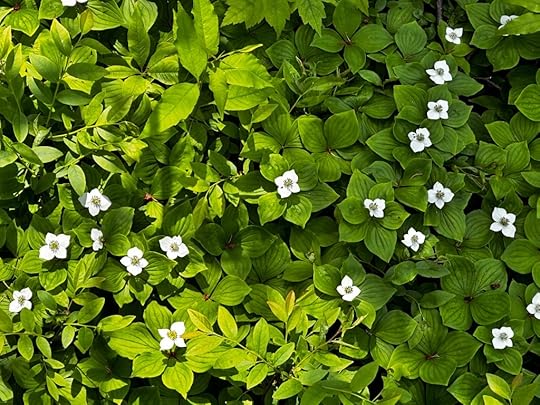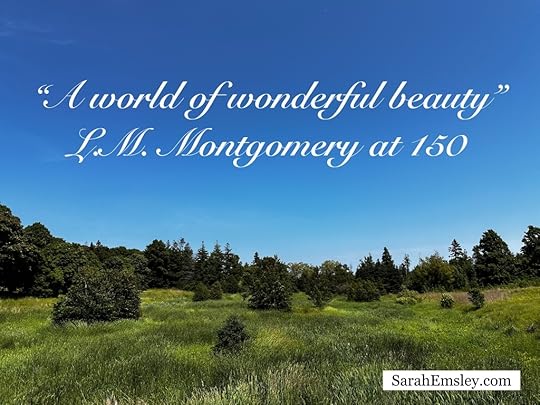Books and Chums, by Trinna S. Frever
As I sit down to write this, I’ve just returned from a book group meeting. We weren’t discussing L.M. Montgomery today. We just finished Marie Benedict’s Lady Clementine, though most of us liked her collaboration with Victoria Christopher Murray, The Personal Librarian, better. While we had a great discussion, I missed not hearing the opinions of Harriet, one of our beloved book group members who recently passed away. Had she been there, her opinions would very likely have been lively and delivered with laughter. That was Harriet’s way, at least in as much as I knew her from the group. I recall with great fondness the many times we’ve sat around a table or Zoomed together “poring over a book,” as L.M. Montgomery says in Anne of Green Gables (Chapter 12). Poring over a book with friends.

(From Sarah: This is the eleventh guest post in “‘A world of wonderful beauty’: L.M. Montgomery at 150,” which began on October 30th and will continue through to Montgomery’s birthday, November 30th. You can find all the contributions to the blog series here . I hope you’ll join the conversations about LMM in the comments here and on social media: #LMM150. Thanks for celebrating Montgomery’s birthday with us!)
All this gets me to thinking that L.M. Montgomery portrayed groups—specifically friend groups—better than almost any author I can think of. Think for a moment of the Story Club of Avonlea or the scholars of Patty’s Place. What a joy it is to see young women in community actually getting along, supporting one another, having fun! Not primarily by demeaning or “taking down” anyone else, but simply by being their glorious selves, together. Isn’t it grand? And though we do see the Avonlea girls engage in some less-than-kindly gossip at the beginning of the Story Club chapter, they become kindlier midway through, almost as if turning those energies to creativity builds their bonds and brightens their outlooks. And it happens while “poring over” books and writing.
I’ve written about The Story Club and Patty’s Place in more detail here. But one thing that strikes me again and again is that these were girls who shared books. They passed them around and talked them over. Then they branched out and wrote stories and essays of their own, not just alone in the quiet of their rooms, but to be shared, together.
Even though Anne is a wee bit critical of the other girls’ writing styles at first:
“Ruby Gillis is rather sentimental. She puts too much love-making into her stories . . . Jane’s stories are extremely sensible. . . . Then Diana puts too many murders into hers. . . .” (Anne of Green Gables, Chapter 26)
The fact is that each girl tells us something about herself when she writes a story. We see Ruby Gillis’ and Jane Andrews’ personalities shine through, and we see a delightfully darker side to the sweeter-than-sweet Diana. We get to know them, and they get to know one another, through their writing and the books they find “fascinating” (Chapter 30). We see girls and young women who share their books and writing and imagination and creativity, and who enjoy each other’s company, together. What a marvelous gift L.M. Montgomery has given us with that portrayal.
Of course, Louisa May Alcott gave us a similar gift with the March girls, up in the attic writing their newspaper and playing “Pickwick” as they had once played Pilgrim’s Progress. They brought their favorite books to life, together, for one another and for us. But for Montgomery, it’s not just about family groups. It’s groups of neighbors and friends. And not just book groups, either. One of my personal favorites is the Avonlea Village Improvement Society, that little-discussed group of civic minded young folk, Anne and Gilbert included (in their pre-romance days), who pal around together while also trying to do some good in the world. There are many more examples, too: the Avonlea school set, the King orchard crowd of The Story Girl and The Golden Road, and the “chums” who gather in the Patty’s Place parlour. Did you know that in Anne of the Island, Montgomery uses the words “chum” or “chummy” twenty-two times? That’s a lot of good friendship. Friends and stories and fun. Together.
As much as I adore Jane Austen, and I do, I’m often ill at ease among her groups, particularly her female groups, because beyond the protagonist, you can scarcely find a friend. If you’re lucky, you get one good friend, usually a sister—a Jane or a Marianne—but the rest of the women are far from companionable. They range from competitive to silly to downright cruel. I don’t just mean an antagonist, a Josie Pye to vex a newly arrived Anne, but rather that all the women in an Austen group, save the one true friend, seem to function in enmity with our protagonist, and she with them.
But in much of Montgomery—all the Anne books, most of the Emily books, both the Story Girl books—the groups are friendly and “chummy.” Even the odd one out, as Anne herself was in the beginning, is still treated like one of the crowd. I find it comforting.

Perhaps I’m drawn to these depictions because they reflect my own experience of the world. As a bookish child, sometimes my life was more like an Austen novel. Many people seemed not to understand, and I found that I’d rather keep the company with myself, with a book-companion, or with one true friend, than spend my time among them. But as I grew, I found more and more people who liked the same things I liked, and who liked me as myself. You could say I came into my Montgomery era. With its advent, I had the good fortune of belonging to many wonderful groups: reading groups and writing groups, book groups and study groups, craft groups and cooking groups, friend groups and fan groups, and even Pokémon Go raiding groups. While I don’t have the rare skill for maintaining all the friendships from all the groups from one stage of life to the next, in my heart, I treasure all the groups. I remember each and every group member fondly. OK, maybe not quite all of them, but even those who seemed a bit Josie Pye-ish at the time mellow with memory. Truly, my experience with groups is far more Montgomery-ish than anything else. Few and far between are the Lydias or the Lucy Steeles, out for themselves no matter who it hurts, or even glorying in the barbs others may feel from the flick of their blade. The groups I recall are collegial and congenial, full of shared thoughts and laughter and goodness and kindness and a willingness to help each other do their best and be their best, both in quiet, homey places and out in the world. I loved them. I still do.
So, when I come to the The Story Girl, for example, and wander into the King orchard to find that mix of extended cousins and neighbors who drop by, listening to stories and telling stories, playing games and eating apples, talking about the past and thinking about the future, and mulling over the ways of the world with one another, it strikes a chord deep in my heart. For this is one of the truest groups of friends I have ever known:
“We had had brotherhood with wind and star, with books and tales, and hearth fires of autumn. Ours had been the little, loving tasks of every day, blithe companionship, shared thoughts, and adventuring.” (Chapter 32)
There it is: friendship. Not just the one friend, the Kindred Spirit, but also the groups of friends, the camaraderie, all bound together with books and trees and the great wide world. I have an essay coming out soon that talks about Montgomery and communities, but what I’m talking about here feels cozier than that somehow. Pals. Chums. Friends.
It seems to me that Montgomery is a master of book-friends. The characters within her books are great friends, to one another and to us. The friends in her books form groups to talk about books and stories and life. And when we, as readers, gather together to talk about her books, and bond over them, we become book-friends with one another. Montgomery creates book-friends for so many of us in so many ways. Those friendships grow with, because of, and alongside the ones in the novels. That, too, is a glorious gift to celebrate on L.M. Montgomery’s birthday.
And the best gift of all? We get to go back and join the old crowd, over and over again, as many times as we please, whenever we recall or reread. When we read in groups, we get to recreate that camaraderie for ourselves and one another. Each time we are welcomed back, whether to a Zoom group or a library, to the Patty’s Place parlour or to the orchard full of storied trees, it is as if we are being welcomed among friends. Because, of course, we are.
All quotations are from the Tundra editions of L.M. Montgomery’s novels.

Trinna S. Frever is a former English professor, current fiction writer, tenured independent scholar, University of Michigan alum, and avid Montgomery fan. Frever’s work, whether fictional or scholarly, explores intersections between books, oral storytelling, music, dance, painting, film, handicraft, folklore, and our ever-expanding concepts of “text” and “story.” She has presented at eleven L.M. Montgomery conferences on Prince Edward Island (sometimes via Zoom), published several essays on L.M. Montgomery, taught the University of Prince Edward Island’s signature course on L.M. Montgomery, and is the creator of #lmmontgomerymonday on Instagram. Her current book project with Kate Scarth, Your LMM Story: The World of L.M. Montgomery and Her Fans (anticipated 2026/2027), collects stories from Montgomery readers to gain insight into Montgomery’s gifts to the world. Originally from Michigan and currently living in Florida, Frever is often drawn to books that feature forests and shores. Learn more at trinnawrites.com. You can find Trinna on Instagram @trinna_writes.

I took the photos in June, on a hike to Greenwich Beach in Prince Edward Island National Park.
If you enjoyed this post, I hope you’ll consider recommending it to a friend. If you aren’t yet a subscriber, please sign up to receive future guest posts in “‘A world of wonderful beauty’: L.M. Montgomery at 150.” The next post, “L.M. Montgomery and the Lucky Cat,” is by Susannah Fullerton.
Here are the links to the last two posts, in case you missed them.
Can’t all Canada agree to like Montgomery (except her poetry)? by Audrey Loiselle
An Emissary of Laughter: L.M. Montgomery and the Saving Grace of Humor, by Liz Rosenberg

Read more about my books, including St. Paul’s in the Grand Parade, Jane Austen’s Philosophy of the Virtues, and Jane Austen and the North Atlantic, here.
Guest post copyright Trinna S. Frever 2024; additional text copyright Sarah Emsley 2024 ~ All rights reserved. No AI training: material on http://www.sarahemsley.com may not be used to “train” generative AI technologies.



